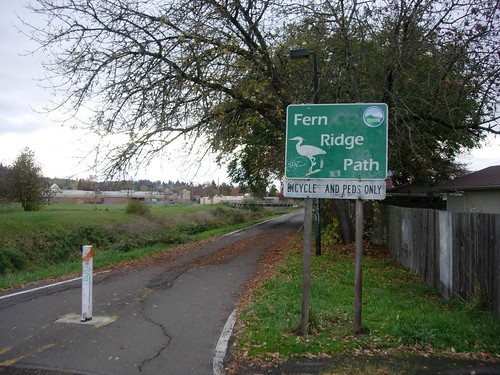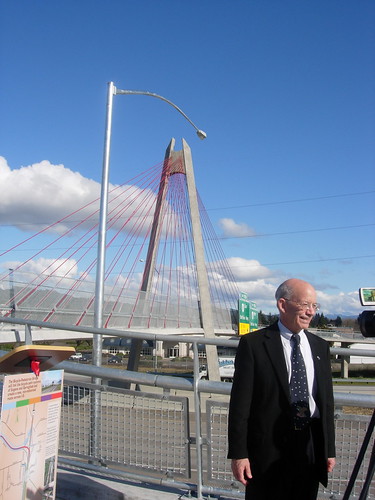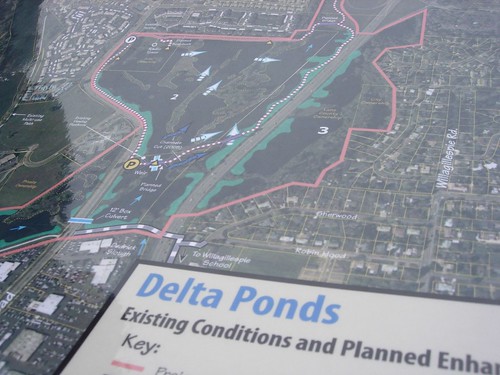An interesting thing happened at Mondays City Council Work Session. Because of a policy recommendation made by the Sustainability Commission that Surface Transportation Program-Urban (STP-U) funds be used for bike/ped projects and not strictly pavement preservation as is currently mandated by council, the council members heard from the community that they would like to revisit this issue. Here is a great wrap-up of that meeting from Howie Bonnett (highlights mine):
Staff (Mark Schoening) had prepared a memo in advance listing three projects for the funds, located on Hilyard, Coburg, and Martin Luther King, which were basically pretty much automobile projects. He also had prepared a memo about how much money had been obtained from various sources for bicycle projects in Eugene in the last 5 years and, due to some big monies recently (stimulus funds for the bridge, etc.,) it averaged 2.5 million per year for bike/ped projects. That seemed to make the Councilors feel that a lot of money was being spent on bicycle/pedestrian projects.
Perhaps somewhat in response to whether the STP-U funds should be spent for alternative transportation modes, Schoening had also listed two bike/ped improvements which could be done in connection with the Martin Luther King and Coburg projects, each costing about 100,000 out of the 2.5 or so million. There followed a discussion of whether these bicycle projects should be bumped to last on the list, or whether they should be done in any case even if the projects required supplemental funds to complete (Schoening offered that gas tax money could be used to make sure the projects were completed). This irritated some councilors, who wanted it clearly stated that the bike/ped work would only be done if it was determined that there was sufficient money for the three road projects, even though Mark Schoening said there would be savings if the bike/ped work was done at the same time as the road repair. A motion to move bikes/ped projects to the bottom of the priority list was made and defeated 5-3 (Poling, Clark, and Solomon losing) and then the main motion passed unanimously which gave the staff authority to add the bike/ped work to the road work on the 3 projects, funded with STP-U funds.
So, net outcome, is that only about 5 % of so of the STP-U funds will go for bike/ped projects, as part of the Coburg and MLK projects. The policy recommendation of the Sustainability Commission was not directly discussed, even though Council has had it for over a month. It is clear that the very large unmet need to do street repair work (now up to 170 million of so), is being used as an argument to suck up all monies for the roads. As I have tried to point out, trying to meet this unmet need as it gets larger and larger, will mean that our ability to build infrastructure to promote alternative mode (active) transportation through diversion of transportation dollars which are discretionary is seriously hampered. Maybe we should have a community discussion about how much money each year it would take to catch up with our unmet road repair needs, and see if we want to undertake that, or whether we should start talking alternatives. Even the 36 million GO Bond measure is a drop in the bucket.
According to Lee Shoemaker, the Cities Bicycle and Pedestrian Coordinator, the projects for the Coburg and MLK projects would be:
Coburg Road Corridor safety improvements for pedestrians and cyclists coordinated with pavement preservation projects that would be funded by STP-U.
And street preservation bond. Could include visual countdown signals, access management where there are willing property owners, and bicycle wayfinding Signage.Martin Luther King Jr. Boulevard Corridor – enhanced pedestrian crossings at east end of corridor coordinated with pavement preservation project that would be funded by STP-U.
Having three council members who voted to move bike/ped projects to the bottom of the last priority is disheartening to say the least and to see the type of projects that should just naturally be part of any complete street talked about being taken off and then highlighted as ‘special bike/ped’ projects sort of rubs salt in the wound. These kind of improvements don’t complete an incomplete network, they simply add what should have been added already.
I also think it is very misleading to have a memorandum that shows $12.5 million in bike/ped projects over the last 5 years when $8.5 million of that was a large bridge project ($5.7 million) and several preservation projects. Take those out and you have about $4 million over 5 years for active transportation projects… $2.5 of that hasn’t been built yet. Which leaves you with $1.5 million new bike/ped infrastructure actually built. How does that compare to non-active transportation projects?
The memo and the Councils reaction to it makes it seem like the City feels it is spending enough on active transportation already. While there has been some great investments and good plans for active transportation we still have an incomplete network that families are afraid to use. We need to be putting large amounts of transportation dollars to completing that network. Bridges are flashy and preservation is essential but we need to be making an investment in the future and that is getting people out of their cars more and active in their transportation choices by having safe and comfortable infrastructure that makes that choice easy.
There are few flexible funds in transportation money. How are we going to complete a network without those funds? We’ll need a plan and we’re working on that with the Bike Master Plan process, but we’ll also need funding! Where is the plan for that funding??
Some calendar items we’ll be looking at for this issue are the MPC public hearing on March 11 and action by the Metropolitan Policy Commission on April 8. Stay tuned for more.






